The gunman breaches a wire fence during the wind down of the Gilroy Garlic Festival’s third, final day. In military-style fatigues and armed with a semi-automatic rifle, 19-year-old Santino William Legan—a last name familiar to those who remember his public office-holding grandfather in the 1980s—marches past a live-music stage and sprays bullets into the crowd.
Hannah Hernandez, 15, stops helping her family pack up their ice cream booth and looks up. Like many people around her, she supposes that someone smuggled in firecrackers. As she glances at Legan, he unloads a second series of shots and stomps forward.
Chaos erupts. Everyone around the shooter screams and sprints, scrambling for a place to hide. The TinMan rock band halts mid-encore as its members dive under the stage. Lead singer Jack van Breen sees a man with a grayish handkerchief around his neck and an assault rifle in his hand, heading towards the food court.
Hernandez bolts back to the counter, where her mom and dad already hunker behind a wood barrier. “That way he couldn’t see us,” she says.
Not far from the Hernandez family, 56-year-old Gilroy real estate agent Lisa Faria pauses upon hearing the same initial gunfire burst. “What idiot would bring firecrackers to a garlic festival?” she recalls thinking as a tense hush fell over fair-goers.
The ex-Gilroy Chamber of Commerce board chair turns to say as much to a colleague, Michele Campbell, 53, when another cluster of loud cracks shatters the silence. A wave of freaked-out bystanders crash toward them in the festival’s bustling Gourmet Alley.
“Take cover! Take cover!” people shriek as they pile up behind the two women.
The gunman murders three people: six-year-old Stephen Romero, 13-year-old Keyla Salazar and 25-year-old Trevor Irby. He wounds at least a dozen more before police draw handguns and kill him, a minute into his rampage.
The gunfire subsides, but panic mounts, as the crowd bolts for a parking lot across an open field. There’s no evacuation plan in place. Elderly people trip in the stampede. Families split up. Attendees who arrived with Uber or Lyft are stranded.
“My friend had blood all over him from helping carry people,” Campbell recounts. “I saw people with gunshot wounds holding their heads but walking.”
Campbell chokes up as the images flash in her mind’s eye.
“I’m sorry,” she sobs. “It hits so close to home.”
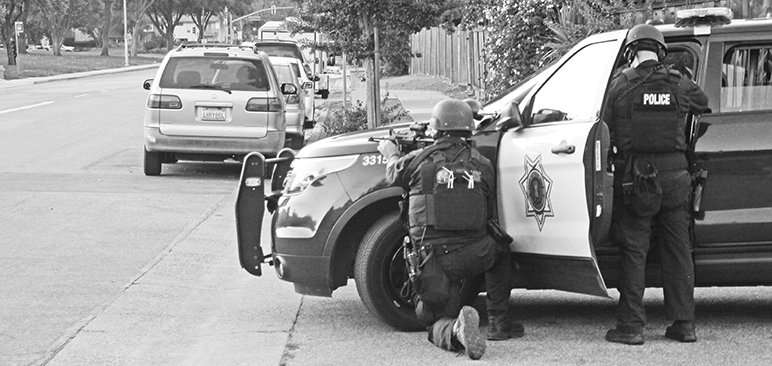
Gilroy PD shot the gunman to death within a minute of him opening fire.
A Tragic Routine
The general narrative is familiar enough. An angry man with a gun airs his grievances by firing his weapon into a crowd—or at an estranged lover, or an overbearing boss. If the shooter makes enough of a spectacle, the story is picked up by international media outlets. Politicians seize on the tragedy in ways both direct and subtle. And people all over the country take to social media, shouting into the electronic ether.
This is what passes for a meaningful debate about gun violence in America. In the aftermath of Sunday’s shooting, local network affiliates ran wall-to-wall coverage of the tragedy, looping helicopter footage of police in tactical gear combing Christmas Hill Park and the surrounding area.
Gov. Gavin Newsom visited victims at Santa Clara Valley Medical Center before delivering an impassioned speech outside the hospital. He inveighed against federal lawmakers for frustrating California’s attempts to rein in gun violence.
“You can’t put borders up ... to a neighboring state where you can buy this damn stuff legally,” he said Monday to a crush of reporters—simultaneously underscoring California’s strict gun control laws and the lax federal regulations that undermine them. The semi-automatic rifle Legan purchased legally in Nevada would have been illegal for him to own in California. “How in the hell is that possible?” Newsom continued. “I have no problem with the Second Amendment. You have a right to bear arms, but not weapons of goddamned mass destruction.”
The first-term governor decried the national government that he says “turns a blind eye and won’t do a damn thing” to prevent gun violence. “California’s doing its part, but Jesus, these guys, the folks in the White House have been supporting the kinds of policies that roll back the work that we’re doing in states like ours to get rid of large-capacity magazines, to address the issues that we’re trying to advance on background checks.”
Just last week, U.S. District Judge Josephine Staton of Santa Ana affirmed the state’s prohibition on semi-automatic rifles with certain key features, including a so-called “bullet button,” which aids in the rapid switching of magazines and allows would-be mass shooters to keep pumping out rounds without pausing to reload their weapon one cartridge at a time. That ruling will almost certainly be taken up by the Supreme Court. If it is struck down by the majority conservative bench, it will be a coup for the National Rifle Association and the gun manufacturers.
Meanwhile, even as police continued to collect evidence from the festival grounds, subscribers to the @GilroyDispatch Facebook page duked it out in the comments section.
“Allow us to be armed to protect ourselves and family,” Chelsea Ferreira wrote. “Good guys with guns are the only way to stop bad guys with guns.”
Tony le Batteur responded: “I wouldn’t trust you with a dull fork to ‘protect us,’ let alone allow you to run loose in a crowd of thousands along with other armed imbeciles and gun fetishists who would undoubtedly do far more harm than good.”
Crystal Johnson jumped in: “I know this town is grieving but [gun] control is not the answer here!”
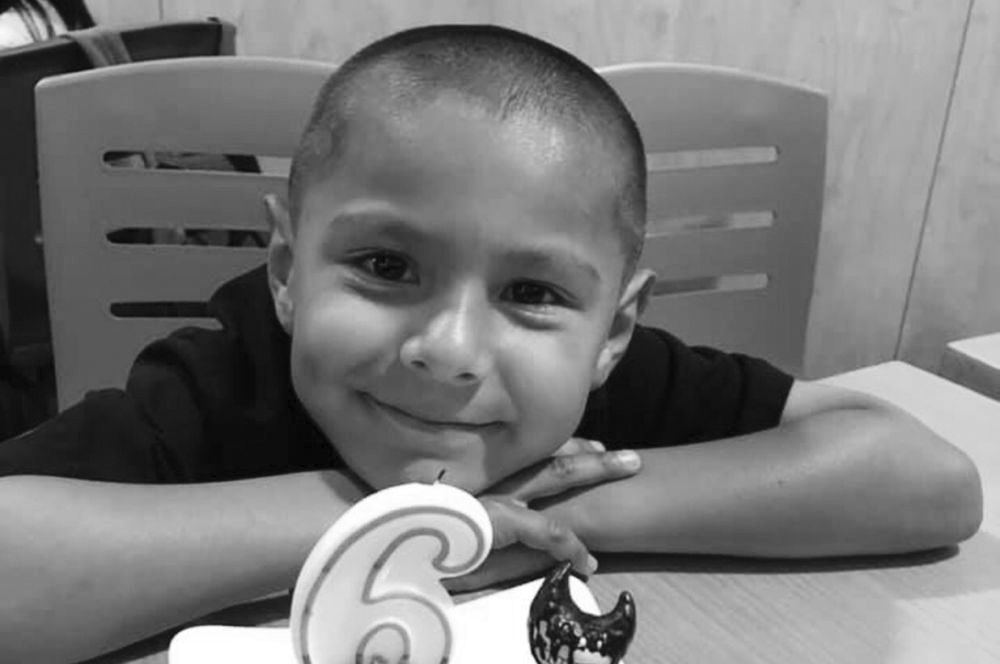
Stephen Romero was the youngest victim, and one of two children from San Jose to die in the gunfire.
Easy Access
John Donahue III used to own a gun but hasn’t for a while. “Like many gun owners, mine was stolen,” Donahue says.
The Stanford law professor built a career on studying gun violence and gun culture in America. He began his research in the mid-1980s. Around that time, violent crime was surging in the U.S. He wanted to know why.
Donahue continued studying the subject as crime dropped steadily through the 1990s. He says he witnessed a correlation between the passage of the Federal Assault Weapons Ban of 1994 and a decline in violent crime.
“I do think there is also a causal factor there,” he says, noting that killers like Adam Lanza, the Sandy Hook shooter, would have had a harder time obtaining powerful weapons if they hadn’t been so readily available.
Donahue concedes that bad actors will find ways to obtain weapons irrespective of the laws in place. He also believes that better safeguards will prevent mentally unstable individuals from undertaking a shooting spree. However, he adds, “It’s just going to be a question of prevalence. The more dads that have assault weapons, the more disturbed children of those dads will find those assault weapons.”
America’s gun problem is both predictable and unique. No other developed nation rivals the United States’ rate of gun violence. It has six times Canada’s gun-homicide rate and nearly 16 times Germany’s.
Though gun violence rates dropped steadily beginning in the 1990s as California imposed strict regulations on semi-automatic weapons, a sharp local and national uptick began in 2014. San Jose responded to 23 percent more gun-related calls in 2017 compared to the prior year, according to Santa Clara County’s Department of Public Health. In addition to lives lost from guns—which averaged about 75 a year in Santa Clara County until the rate climbed in the past five years—firearms exact a staggering economic toll.
In 2013, public health officials estimated that gun violence cost the county more than $112 million in medical bills, lost productivity and other factors. Researchers for the Gifford Law Center to Prevent Gun Violence estimate that firearms cost the American economy as a whole about $229 billion a year. Though California has some of the nation’s strongest gun laws and lowest gun death rates, firearms still rack up $6.5 billion a year in directly measurable costs, according to the pro-gun control think tank.
“If California’s gun death rate remained at its 1993 level, when California’s gun laws were relatively weak, gun violence would currently cost the state over $41 billion each year,” per a 2018 Gifford Law Center report. “Additionally, if California’s gun death rate was as high as a state like Louisiana, which has some of the weakest gun laws in the nation, the cost of gun violence in California would total approximately $45 billion annually.”
Banning so-called assault rifles, closing private sale loopholes, preventing batterers and the mentally unstable from buying weapons and cracking down on high-capacity magazines would go a long way toward preventing gun violence, Donahue says. The Centers for Disease Control’s firearm mortality data consistently bear this out: states with fewer guns experience fewer gun-related deaths, including murders and suicides.
However federal law often undermines the strictest state-level controls.
Buying guns in lax locales and then transporting them across state lines is so common that the route between Southern states and New York City has become known as “The Iron Pipeline.” Chicago’s ban on retail gun shops is rendered toothless by the proximity of Indiana’s freewheeling gun shows.
Even California’s toughest-in-the-nation gun laws couldn’t keep Legan from bringing his AK-47-variant from Big Mikes Guns & Ammo in Nevada, to his family home in Gilroy.
Another roadblock to meaningful change that Newsom didn’t address during his recent visit to the South Bay: the vast, unrivaled and unprecedented quantity of firearms in the United States. Americans own nearly 400 million of the world’s guns. That’s about half the civilian-owned firearms on Earth in a nation comprising less than 5 percent of the planet’s population.
Are there simply too many guns to control?
Perhaps not. Donahue has a theory about the recent rise in gun violence and mass shootings. For him, it boils down to a combination of irresponsible marketing and increased access—and he blames the NRA and the gun industry as a whole for both.
“The NRA has managed to re-create history, in a way,” he says. It’s true that guns have always loomed large in the American psyche. However, it has taken concerted advertising campaigns and serious lobbying to convince the public and lawmakers that every American adult ought to have the right to own weapons that are almost identical to those carried by U.S. soldiers.
It’s true that military issue rifles are often capable of fully automatic fire—squeeze the trigger and the gun will continue pumping out rounds until it runs out of ammo. However, this function interferes with accuracy, causes the weapon to heat up quickly and can be thwarted by a mechanical jam. “Most of the time the military uses these weapons in semi-automatic firing mode,” he says.
The idea that every citizen ought to be able to go toe-to-toe with ground troops has also been stoked by gun manufacturers and the NRA—more specifically by Ackerman McQueen, the NRA’s advertising and PR agency, which has served the gun group for more than three decades. The Oklahoma-based firm is responsible for such slogans as, “It’s not just about guns. It’s about freedom.”
Through his studies, Donahue has had a front seat to this “interesting intellectual transition,” which has seen the NRA evolve from an organization founded to represent hunters and sportsmen into what it is today—a massive lobbying and marketing engine for the American gun industry.
In other words, the mythology embraced by so many gun-rights advocates does not run as deep as many would believe. It was manufactured in the same way our need for the latest and greatest gadgets are manufactured—by Madison Avenue creatives. And it happened over the course of a single generation.
If Americans can learn to turn their backs on something as physically addictive and aggressively marketed as tobacco, surely we can learn to unfriend guns. And looking purely at the numbers, we’d be better off if we could.
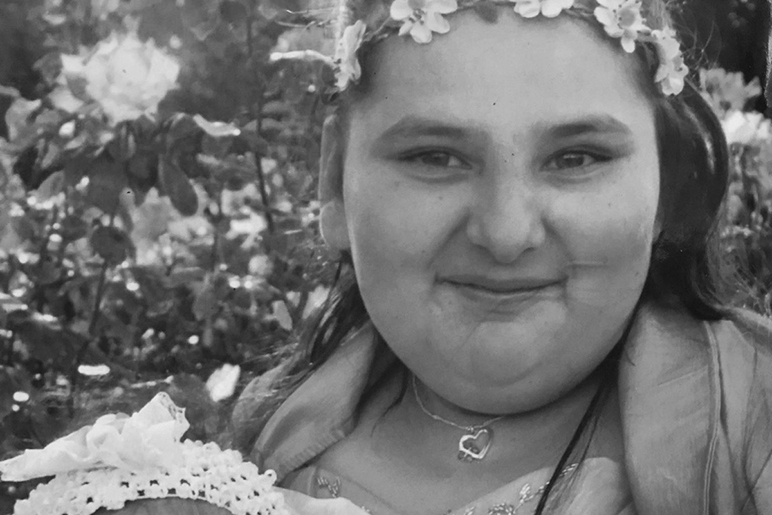
Keyla Salazar, one of the three to die in Sunday's massacre, would have celebrated her 14th birthday in the next month.
Fire Away
Little more than halfway through 2019, the national tally of mass shootings—generally defined as those with a few or more casualties—hit 246, with a rash of massacres this past weekend. Between Saturday and Sunday alone, seven mass shootings struck communities in California, New York, Illinois, the District of Columbia, Pennsylvania and Kansas. Over that same two-day span in Chicago, guns killed eight people and injured 40 others. A day before and 3,000 miles away from the Gilroy shooting, a gunman killed one and injured 11 others at a music festival in Brooklyn.
In the past five weeks, three prominent cases of gun violence struck the South Bay: one at a workplace, another at a family home and the latest at a venerated culinary celebration.
On June 25, 60-year-old Steven Leet walked into the Morgan Hill Ford Store where he’d been fired earlier that day. After lingering for a while in the parts department, he charged into the office and shot his supervisor, Xavier Souto, at point-blank range in the head with a .38 caliber revolver. Another manager, Brian Light, brought Leet to the ground in a move police would later call “nothing short of heroic.” But the gunman fired several more shots during the scuffle, killing Light.
Colleagues hid behind desks and customers dropped to the floor. Cops arrived minutes later to find Leet slumped on a curb from a self-inflicted gunshot wound. Authorities called the incident Santa Clara County’s bloodiest workplace massacre in eight years.
Two days before Leet slaughtered his co-workers, San Jose police responded to a hostage situation that ended four hours later in a quintuple murder-suicide.
The man who fatally shot four relatives before taking his own life, 66-year-old Chi Dinh Ta, somehow acquired a Springfield XD 9mm semi-automatic handgun despite decades-old robbery convictions that barred him from owning or having firearms.
Ta had reportedly been wracked with jealousy over his wife sponsoring relatives from Vietnam for visas when he could not because of his past felonies. According to SJPD, Ta murdered his wife’s relatives—23-year-old Thanh Hoa Hoang and 42-year-old Thi Que Pham—around 8:40pm June 23 at his Habbitts Court home. He shot two others, 51-year-old Le Thuy Hoang and 48-year-old Phung Ngoc Hoang, who survived. His wife, daughter and niece managed to escape.
In the hours before Legan began indiscriminately spraying bullets into the crowd at the Gilroy Garlic Festival—an annual gathering of thousands of families on 60 acres that raises millions of dollars for charity—he published a series of photos on his sparsely used and since-deleted Instagram account.
Among them, an image of a Smokey the Bear sign warning about fire danger and urging people to read Might is Right, a white supremacist manifesto on social Darwinism that calls on the “strong” to dominate the “weak.” His plug for the tome was followed by the question, “Why overcrowd towns and pave more open space to make room for hordes of mestizos and Silicon Valley white twats?” In another entry, he uploaded a picture of his maternal grandfather, named as Ali Asghar Vahabzadeh, with a remark about “anglicizing” his Iranian surname to Baylor.
A third post appeared to be taken from the garlic festival about an hour before police fielded the initial calls about a shooting that night. It read, “Ayyy garlic festival time come get wasted on overpriced shit.”
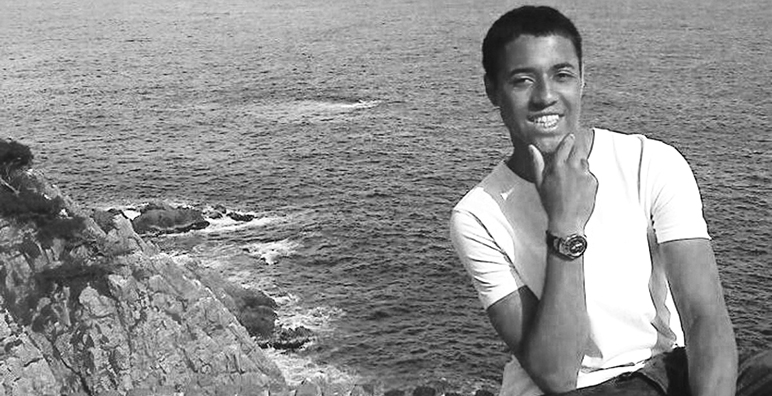
Trevor Irby, 25, was a recent college grad hanging out with his fiancée by the festival's Gourmet Alley when he was killed.
Turning Japanese
Gun rights advocates could rightly say all of these men were unstable. It’s hard to imagine that anyone would dispute that. But to argue that mass shootings are inevitable simply because there will always be maniacs in the world is to ignore examples of other countries where gun control has worked. Donahue points to Japan.
A nation of 127 million, Japan has a similar media landscape to the United States. Violent video games and movies abound. However, strict gun control laws make it much harder for citizens to use a gun when acting on their worst impulses. Though no country is a perfect analog for another, and while cultural differences obviously play a role, Japan averages around 10 gun deaths per year.
But turning from Japan, which enacted gun controls far earlier in its history, and looking at Australia, Donahue says it’s possible to see how a country can shift cultural norms through legislation.
In 1996, 28-year-old Martin Bryant killed 35 and wounded another 23 in a cafe on the island of Tasmania. The reaction was swift and decisive. John Howard, Australia’s then-prime minister, convinced lawmakers to act quickly to enact sweeping changes to the existing gun laws. Restrictions were dramatically tightened, a national registry was created and a mandatory buyback of all prohibited firearms was instituted.
This National Firearms Agreement, as the law was called, seems to have accomplished its goal. A 2011 Harvard study concluded that the rates of suicide and homicide by gun were each slashed by about half.
In America’s current political climate such a program is unimaginable, Donahue says. And while the Democrat-controlled House passed a bill that would require universal background checks for gun sales, President Donald Trump has vowed to veto it should it ever cross his desk.
Survival Techniques
Initial reports of a mass shooting detail a body count, which ticks up as the hours pass, and whether the gunman is active, dead, at large or detained. Names of victims usually trickle out over the next day, first from friends and family and then from the coroner.
As the investigation proceeds, we begin to hear more about the gunman, what he looked like and where he came from and how normal or quiet he seemed to neighbors. The lingering question, for which there’s never a good answer is, “Why?”
Senior FBI agent Craig Fair told reporters on Monday that a team of 30 investigators are trying to figure out Legan’s affiliations and ideological bent. “Our pre-eminent and principal concern,” he said, “is motivation.”
That’s more of a concern for law enforcement, however. For survivors trying to heal, many of them interviewed for this story say it doesn’t really matter whether a killer was motivated by jealousy or despair, hate for their boss, hate for women, hate for immigrants or hate for America.
“I think that healing process has to be done in large part with these vigils,” says Gilroy Chamber of Commerce President Mark Turner, who was in the thick of the gunfire trying to help people when Legan squeezed off a hail of bullets. “A lot of it is coming together, sharing what you’re going through and memorializing the victims.”
Jaqueline McCool also contributed to this report.

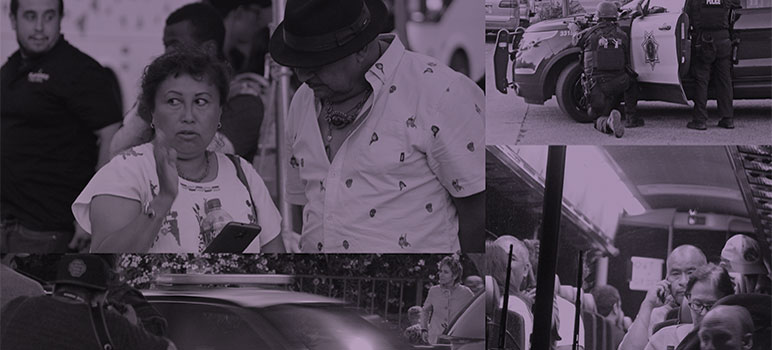
> Senior FBI agent Craig Fair told reporters on Monday that a team of 30 investigators are trying to figure out Legan’s affiliations and ideological bent.
And when investigators figure this out, then what?
What do they do with this information?
Harmful social phenomena are typically not properly addressed because of the extreme ideologies of those on the left and right. I am pro-gun control. I do not own a gun and do not plan to own one. However, being pro-gun control does not mean I want to take others’ right to own guns. What it means is the regulation of who owns them has to be stricter and the same about the types of guns people can own. Obtaining a gun legally should not be easier than obtaining a driver’s license. This case makes evident that those who want to create harm will take any step to do so. While the causes as to why people want to engage in mass killing can be many, working on taking the means to kill should be law makers’ focus state and nationwide. Any of us can be the next to be killed in this way. Abortion is another polarized topic each side trying to force the other being one side or the other. I am a pro-life democrat and a Christian. Being pro-life does not mean I want women to die from illegal abortions. I have a right to be pro-life the same way others have a right to be pro-choice. Those trying to force their pro-chice on me are basically trying to force me to stop being a Christian. This will be as wrong as me trying to force other be a Christian. I am a centric democrat. Being centric does not mean we work on making everyone happy. It means creating and supporting laws and politicians that promote justice for all not only to left or right. I voted for late John M, Hillary C, and will vote for #KamalaHarris2020. I will never vote for Sanders, Warren, or Trump; EXTREMISTS!
Sanders and warren are nowhere near the same as trump! Stop spewing your uninformed bs.
California should be an independent country so that it can enact its own laws on gun control and other matters. The Governor is irresponsible for failing to advocate secession. The state needs better leaders.
We must remain vigilant. Perhaps if more people were visibly armed, fewer extremists would feel they could take advantage of them.
If California despises and hates the Constitution and individual freedom so much, they should become their own country and institute their utopian totalitarian socialist dictatorship there, and all those who hate freedom and rights can go live there and knock themselves out in all the authoritarianism they can take. It’s when California wants to turn the entire nation in a socialist dictatorship that I have a problem.
So, you’re ok with the dictatorship of trump. Got it. Learn about democratic socialism. There is nothing radical about it. Asking that our tax dollars work for us rather than corporate interests is not radical. Asking that everyone have access to affordable medical care AS A HUMAN RIGHT is only radical to people who lack basic human decency.
Why do DS people refer to each other as comrade and dress up as communist leaders (who massacred innocent people, suppressed the press, quarantined gays, etc.) if they don’t want to be mistaken for communists?
Why does this type of system inevitably require totalitarianism in its implementation?
Is it really so wrong to reward productivity? I’d gladly reward people equally if peoples outputs were equal, but they are not.
Venezuela used to be the 4th richest country in the world per capita (which would look even better by modern PPP). They have tremendous natural resources, fertile land, formerly educated population. But in less than a generation we now see them eating from garbage cans, eating zoo animals, smuggling food just to survive.